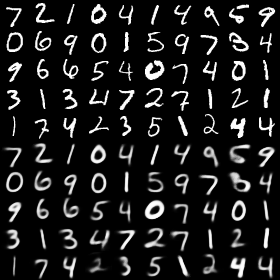A Keras implementation of CapsNet in the paper:
Sara Sabour, Nicholas Frosst, Geoffrey E Hinton. Dynamic Routing Between Capsules. NIPS 2017
The current average test error = 0.34% and best test error = 0.30%.
Differences with the paper:
- We use the learning rate decay with
decay factor = 0.9andstep = 1 epoch,
while the paper did not give the detailed parameters (or they didn't use it?). - We only report the test errors after
50 epochstraining.
In the paper, I suppose they trained for1250 epochsaccording to Figure A.1? Sounds crazy, maybe I misunderstood. - We use MSE (mean squared error) as the reconstruction loss and
the coefficient for the loss is
lam_recon=0.0005*784=0.392.
This should be equivalent with using SSE (sum squared error) andlam_recon=0.0005as in the paper.
Recent updates:
- Correct the
Maskoperation. Now all digit capsules are connected to the decoder simultaneously. - Change default
epochsfrom 30 to 50. - Define a separate model for test phase which does not require ground truth
yas input. - Fix #13
- Report test errors on MNIST
TODO
The model has 8M parameters, while the paper said it should be 11M.
I have figured out the reason: 11M parameters are for the CapsuleNet on MultiMNIST where the image size is 36x36. The CapsuleNet on MNIST should indeed have 8M parameters.- I'll stop pursuing higher accuracy on MNIST. It is time to explore the interacting characteristics of CapsuleNet.
Contacts
- Your contributions to the repo are always welcome.
Open an issue or contact me with E-mail
guoxifeng1990@163.comor WeChatwenlong-guo.
Step 1. Install Keras with TensorFlow backend.
pip install tensorflow-gpu
pip install keras
Step 2. Clone this repository to local.
git clone https://github.com/XifengGuo/CapsNet-Keras.git
cd CapsNet-Keras
Step 3. Train a CapsNet on MNIST
Training with default settings:
$ python capsulenet.py
Training with one routing iteration (default 3).
$ python capsulenet.py --num_routing 1
Other parameters include batch_size, epochs, lam_recon, shift_fraction, save_dir can be
passed to the function in the same way. Please refer to capsulenet.py
Step 4. Test a pre-trained CapsNet model
Suppose you have trained a model using the above command, then the trained model will be
saved to result/trained_model.h5. Now just launch the following command to get test results.
$ python capsulenet.py --is_training 0 --weights result/trained_model.h5
It will output the testing accuracy and show the reconstructed images. The testing data is same as the validation data. It will be easy to test on new data, just change the code as you want.
You can also just download a model I trained from https://pan.baidu.com/s/1nv9SMFn
Test Errors
CapsNet classification test error on MNIST. Average and standard deviation results are reported by 3 trials. The results can be reproduced by launching the following commands.
python capsulenet.py --num_routing 1 --lam_recon 0.0 #CapsNet-v1
python capsulenet.py --num_routing 1 --lam_recon 0.392 #CapsNet-v2
python capsulenet.py --num_routing 3 --lam_recon 0.0 #CapsNet-v3
python capsulenet.py --num_routing 3 --lam_recon 0.392 #CapsNet-v4
| Method | Routing | Reconstruction | MNIST (%) | Paper |
|---|---|---|---|---|
| Baseline | -- | -- | -- | 0.39 |
| CapsNet-v1 | 1 | no | 0.39 (0.024) | 0.34 (0.032) |
| CapsNet-v2 | 1 | yes | 0.36 (0.009) | 0.29 (0.011) |
| CapsNet-v3 | 3 | no | 0.40 (0.016) | 0.35 (0.036) |
| CapsNet-v4 | 3 | yes | 0.34 (0.016) | 0.25 (0.005) |
Training Speed
About 110s / epoch on a single GTX 1070 GPU.
Reconstruction result
The result of CapsNet-v4 by launching
python capsulenet.py --is_training 0 --weights result/trained_model.h5
Digits at top 5 rows are real images from MNIST and digits at bottom are corresponding reconstructed images.
The model structure:
-
Kaggle (this version as self-contained notebook):
- MNIST Dataset running on the standard MNIST and predicting for test data
- MNIST Fashion running on the more challenging Fashion images.
-
TensorFlow:
- naturomics/CapsNet-Tensorflow
Very good implementation. I referred to this repository in my code. - InnerPeace-Wu/CapsNet-tensorflow
I referred to the use of tf.scan when optimizing my CapsuleLayer. - LaoDar/tf_CapsNet_simple
- naturomics/CapsNet-Tensorflow
-
PyTorch:
-
MXNet:
-
Lasagne (Theano):
-
Chainer:



